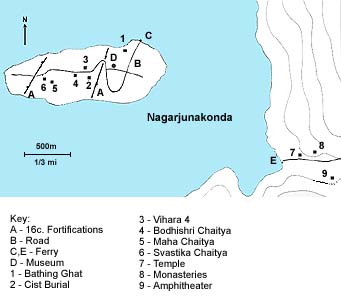
Nagarjunakonda
Early Buddhist Settlement
Ikshvaku Dynasty (3d-4th centuries A.D.)
166km (103mi) SE of Hyderabad

|
NagarjunakondaEarly Buddhist Settlement
|
The early Buddhist settlement of Nagarjunakonda (ancient Sriparvata, also called Vijayapuri) was the capital of the Ikshvaku dynasty (c. 225 A.D. - 325 A.D.), who were the successors of the Satavahanas in the Eastern Deccan. Nagarjunakonda means "Nagarjuna's Hill;" it is named after the great Buddhist teacher Nagarjuna himself, who is traditionally believed to have founded the site in the first or second century A.D. During the early centuries A.D., the site housed more than 30 Buddhist monasteries; excavation has yielded art works and inscriptions of great importance for understanding the history of this early period.
Archaeological disaster struck in 1960, when an irrigation dam, the Nagarjuna Sagar, was constructed downstream across the Krishna River. This created a reservoir, which submerged most of the original site. In advance of the flooding, several monuments were dug up and relocated to the top of Nagarjuna's Hill, which is now an island in the middle of the reservoir. Other monuments were relocated to the mainland village of Anupu, just east of the flooded area.

|

|